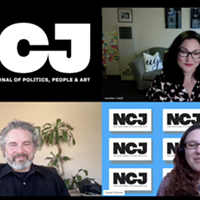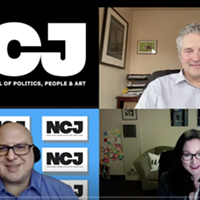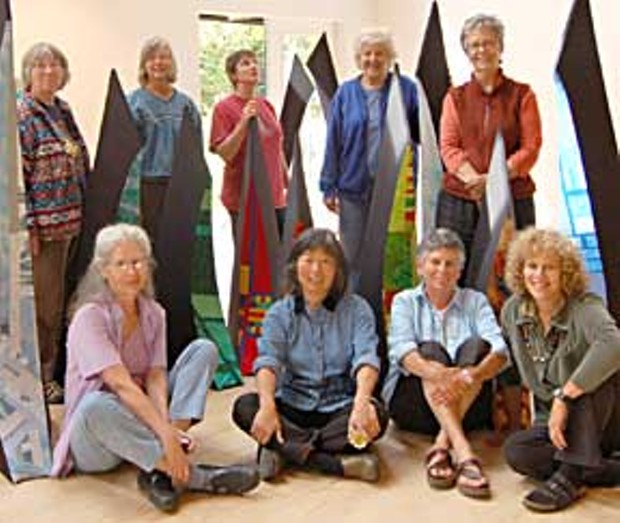[
{
"name": "Top Stories Video Pair",
"insertPoint": "7",
"component": "17087298",
"parentWrapperClass": "fdn-ads-inline-content-block",
"requiredCountToDisplay": "1"
}
]
Art collectives have probably been around as long as people and art. Groups of artists get together for a variety of reasons: to share resources, exchange ideas and tips on technique, to critique each other's work. Some groups, such as the Futurists of the early 20th century, formalized and wrote long manifestos, and certainly had an influence on current events. Others are more humble, and their purpose is the simple encouragement of people who share similar struggles, hopes and concerns.
That's along the lines of what the local collective Seven + is about. Marie Kelleher-Roy, one of the founding members, writes, "Lorraine [Miller-Wolf] and I were sharing with each other, how challenging it was to do shows by oneself and wondered if we got a group of art friends together if it would be easier. Our original plan has proved to be successful as we have had three group shows and many of our members have had more showing of their work also."
Several of the group members (interviewed by e-mail) talked about the sharing of ideas, the "synergy" of the collective, the energizing effect of meetings. Amy Uyeki writes, "This art group has been important to me more for the free sharing of ideas that goes on, the networking, the exchange of concepts and techniques."
Creating visual art is often done alone, but creativity is fueled by talking over ideas with others. The arts collective remedies this conundrum. Nancy Head writes poetically about the experience. "I am alone in my studio with my thoughts and process. I fall into the emotional layers of love and despair on each piece of work. I look to my group for caring, honesty and encouragement with an understanding of the human condition."
I turned to this group of wise women because I've been thinking a lot about art lately. Well, of course, I'm always thinking about art, but it's a little more focused now because I'm going to be giving a presentation on how important art is to all of us, not just those who call themselves artists (more details at the end of the article). My opinion is that we are all artists, that we owe it to ourselves to find our artistic voice, and even that we have an obligation to do so. So I asked the Seven some basic questions: "Why do you do art?" "Do you think creativity is inherent in human beings?" "What do you think when people say they are not creative?" "What is your definition of art?"
Freedom and voice were the two main themes that came up in the resulting discussion of why these artists do what they do. "I love doing it," says Iris Schenke. "There is such a sense of freedom - of something without rules or limits." Says Barbara Dolan-Wilkinson, "Art is my internal language. Without it, I would be mute in my ability to communicate with society." And finally, Amy declares, "Art has been 'my voice,' for as long as I can remember."
I think this is important because it helps explain why art is critical in every person's life. It's a language that expresses the fullness and complexity of the human experience. We are constantly questioning and striving to understand our place on this planet, and by using the language of art, we can begin to capture the ideas and emotions. Art is the way that we work things out in our own heads. It is the way that we communicate to each other, to our descendants, to those of other cultures our conclusions. The artists in this collective are primarily visual artists (painters, sculptors, photographers), but I also include poetry, storytelling, dance, music - any creative outlet - in my concept of art.
There was consensus among the group that art is for everybody and that it has applications far beyond the production of various pieces hangings on walls that many tend to use as a limited definition of "art."
Several of the Seven +ers brought up the fact that people who don't think they are artistic are using too narrow a definition of the word. Lorraine Miller-Wolf says, "I believe that the creative spirit can manifest itself in every aspect of life; thus, a person may not be able to paint or draw, but creates a fabulous garden, or raises talented, accomplished children or is a fabulous cook or writes lovely letters to friends/family. The possibilities for creativity are endless within each of us, it's a matter of broadening the definition of creativity, as well as having opportunities to explore our creative energies."
Kathleen Zeppegno writes about her experience using art therapy with kids. "The children were able to express themselves through art making, sharing many feelings through their imagery, and often the story of their lives would unfold through art. Art is powerful in all forms."
But sadly usually only a handful of kids find their way into programs that teach them how to understand and express themselves in the language of art. It should be the standard, and not the odd after-school program, that teaches art. Nancy writes, "We are faltering in refusing to honor what is a big part of our being human."
While I believe with all of my heart that art is (or ought to be) a critical part of every person's experience, it is often hard to explain why. It can't be calculated in the terms that we usually use for measuring worth. There is a tendency in our society to concentrate only on the economic value of a thing and ignore worth based on the quality of life it brings. But economic value is only an incidental, in my book. What is much more valuable is art's ability to help us in our struggle to make meaning out of our existence.
That struggle has no simple answer - the value of art is its capacity to incorporate the paradoxes of life. While I hesitate to pin myself down to any one definition of art, I quite like the way Amy Uyeki captured its ambiguity: "It's not the answer, but it's a question asked to answer a question."
Questions like those will be addressed in a presentation I'm giving at the Humboldt Unitarian Universalist Fellowship (24 Fellowship Way, off Jacoby Creek Road in Bayside) on May 13, at 9:00 and at 11:00 am. I encourage anyone who is interested to attend. My plan is to offer a collection of the wisdom and ideas I get from some of the amazing people I talk with when I'm working on this column. E-mail me or check out the HUUF website www.huuf.org for more details.
Speaking of Art
-

Disaster Response, Crowley, Art in Piles and Salsas
Sep 7, 2023 -

NCJ Preview: Abalone, KHSU and Help in the Storms
Jan 15, 2023 -

NCJ Preview: Potter Plans, Measure S, Masks and Analog Art
Feb 12, 2022 - More »
more from the author
-
Obama and the Arts
Do we really need -- or want -- a Ministry of Culture?
- Feb 5, 2009
-
Humboldt Wild
By Arleen Olson. Self-published.
- Feb 5, 2009
-
Colors Flowing Like Water
Rande Rothman's silk paintings
- Jan 15, 2009
- More »
































